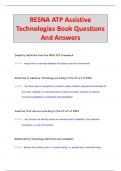RESNA ATP Assistive
Technologies Book Questions
And Answers
Disability definition from the WHO ICF framework
✓✓✓✓~ results from a mismatch between the person and their environment
Definition of Assistive Technology according to the AT act of 2004
✓✓✓✓~ "any item, piece of equipment or product system whether acquired commercially off
the shelf, modified, or customized that is used to increase, maintain or improve
functional capabilities of individuals with disabilities"
Assistive Tech Service according to the AT act of 2004
✓✓✓✓~ "any service that directly assists an individual with a disability in the selection,
acquisition, or use of AT device"
Rehabilitation Technology (definition and examples)
✓✓✓✓~ devices with primary use in a clinical setting, ex. parallel bars, overhead slings
,Educational Technology (definition and examples)
✓✓✓✓~ make educational materials more accessible such as software programs and braille
or audio books
AT for personal use (definition)
✓✓✓✓~ individualized and usually follows the person
What are the components of the HAAT Model?
✓✓✓✓~ Human, Activity, Assistive Technology, Context
Definition of Information and Communication Technologies
✓✓✓✓~ Includes computers mobile phones and tablets
Definition of everyday technologies
✓✓✓✓~ Pervasive technology that facillitates everyday tasks and activities for example
remote controls, microwave ovens, mobile phones
Definition of mainstream products
,✓✓✓✓~ Devices and seervices that are used by the general public rather than being
dessigned speciificcally forr peopple with disabilitiies foorr example mobiile phones,
taablets and ccompuuters
What is the everyday technology use questionnaire (ETUQ)
✓✓✓✓~ Clinical tool that assesses the perceived relevance of, and difficulty in use of,
everyday technology.Includes both ICT's as well as common household technologies
such as an iron, stove, radio, microwave, and televisions and DVD players.
Technologies outside the home such as elevators, code operated door locks, ATMs,
and automated flight check-in are also included.
Examples of mainstream technologies that were originally developed for people
with disabilities
✓✓✓✓~ Cassette tapes, audiobooks, typewriter, ballpoint pen, carpenters miter blocks,
telephone, texting, Closed captioning, voice recognition, on-screen keyboards,
speechh synthesis and digitized speech, mouse keys, sticky keys, word prediction,
toggle switches, customizable color schemes, screen enlargement, head tracking
devices, single switch hardware interfaces example PowerPoint remote, swype text
input for touchscreens
Definition of universal design
, ✓✓✓✓~ The design of products and environments to be usable by all people, to the
greatest extent possible, without the need for adaptation or specialized design
Benefits of universal design
✓✓✓✓~ Less expensive than modifying a product after production
Examples of universal design
✓✓✓✓~ Sidewalk curb cuts, automatic doors, low buttons on elevators, audible crosswalk
signals, elevators, large bathroom stalls
Seven principles of universal design




